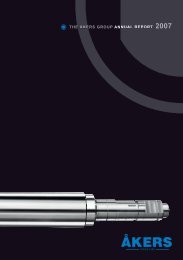CAEF Roll failures manual - The Åkers Group
CAEF Roll failures manual - The Åkers Group
CAEF Roll failures manual - The Åkers Group
Create successful ePaper yourself
Turn your PDF publications into a flip-book with our unique Google optimized e-Paper software.
4.2 Inclusions<br />
4.2.1 Description<br />
Non metallic inclusions may be of different size and appearance.<br />
4.2.2 Origin<br />
Different sources are possible, such as slag or flux entrapment<br />
or foreign particles coming from the mould or casting<br />
equipment.<br />
This is always a roll fault and threatens surface quality but<br />
does not normally lead to massive roll <strong>failures</strong>.<br />
4.2.3 Remedy<br />
<strong>The</strong> roll maker has to pay particular attention to cleanliness of the liquid metal before casting and<br />
the integrity of the casting mould as well as a good foundry environment. From a certain size, defects<br />
of this type can be detected by ultrasonic inspection before delivery.<br />
4.3 Hard and Soft Spots<br />
4.3.1 Description<br />
21<br />
Section 4 SURFACE AND SUBSURFACE DEFECTS<br />
<strong>The</strong>se surface and/or subsurface defects appear as circular or semicircular, white or grey spots within the shell material and are eit-<br />
her harder or softer than the surrounding base metal. <strong>The</strong>y normally do not appear as a localised single defect but generally affect<br />
a large part of the roll body.<br />
4.3.2 Origin<br />
Different explanations may be given to this phenomenon<br />
which is limited to spun cast rolls. Hard spots present a concentration<br />
of segregated iron carbides where as soft spots<br />
show carbide depleted or graphite enriched areas. One cause<br />
is probably the segregation effect triggered by a gas bubble,<br />
which is pushed by centripetal force, through the shell metal<br />
just before final solidification. <strong>The</strong> gas originates from sudden<br />
decomposition of the water of crystallisation contained in the<br />
binder of the coating material. Other theories may be linked<br />
to excessive vibration of the mould during spin casting which<br />
influences segregation during solidification at the solid/liquid<br />
interface.<br />
This is a roll fault which can result in surface marking of the<br />
strip but not severe <strong>failures</strong> in service.<br />
4.3.3 Remedy<br />
<strong>The</strong> roll maker should ensure good mould condition and coating preparation and<br />
avoid excessive vibration of the mould during spin casting.<br />
cm




